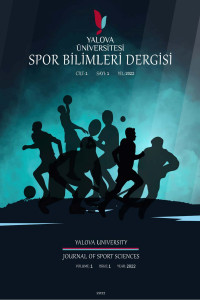Examining The Effects Of Performing Individual Fitness Exercise In The Form Of Group Fitness Exercises On Some Parameters
Group fitness, Individual fitness, Body composition, Strenght, Balance
___
- Angın, E. (2008). Postmenopozal Osteoporozlu ve Osteopenili Kadınlarda Grup Egzersizinin Kemik Mineral Yoğunluğu, Fiziksel Parametreler, Yaşam Kalitesi Üzerindeki Etkileri. Yayımlanmamış Yüksek Lisans Tezi, Hacettepe Üniversitesi, Sağlık Bilimleri Enstitüsü, Fizik Tedavi ve Rehabilitasyon Anabilim Dalı, Ankara.
- Athletics and Fitness Association of America, (2019). Principles of group fitness instruction (2nd ed.), E.A. McGill (Ed.). Burlington: Jones & Bartlett Learning.
- Badat, T. (2018). Sağlıklı Kadınlarda Bireysel Egzersiz ve Grup Egzersiz Eğitiminin Fiziksel Performans Üzerine Etkilerinin Karşılaştırılması. Yayımlanmamış Yüksek Lisans Tezi, Hasan Kalyoncu Üniversitesi, Sağlık Bilimleri Enstitüsü, Fizyoterapi ve Rehabilitasyon Anabilim Dalı, Gaziantep.
- Barnett, A., Smith, B., Lord, S.R., Williams, M., and Baumand, A. (2003). Community-based group exercise ımproves balance and reduces falls in at-risk older people: a randomised controlled trial. Age and Ageing, 32(4), 407-414.
- Cohen, J. (1988). Statistical power analysis for the behavioral sciences (2nd Ed.). New York: Lawrence Erlbaum Associates. ISBN: 0-8058-0283-5.
- Çolak, F.D. (2008). Sağlıklı bireylerde aerobik egzersiz ile su içi egzersizlerin fiziksel uygunluk parametrelerine olan etkilerinin karşılaştırılması. Yayımlanmamış Yüksek Lisans Tezi, Hacettepe Üniversitesi, Sağlık Bilimleri Enstitüsü, Fizik Tedavi ve Rehabilitasyon Anabilim Dalı, Ankara.
- Desbiens, C., Filion, M., Brien, M., C., Hogue, J.C., Laflamme, C., and Lemieux, J. (2017). Impact of physical activity in group versus individual physical activity on fatigue in patients with breast cancer: A pilot study. The Breast, 35, 8-13.
- Guy, J.A., and Micheli, L.J. (2001). Strength training for children and adolescents. Journal of The American Academy of Orthopaedic Surgeons, 9(1), 29-36.
- Gültekin, D., and İrez, G.B. (2016). Aero-pilates çalışmasının üniversite öğrencilerinin bazı fiziksel uygunluk değerleri üzerine etkisi. CBÜ Beden Eğitimi ve Spor Bilimleri Dergisi, 11(2), 141-147.
- Kipp, L. (2016). Psychosocial aspects of youth physical activity. Pediatric Exercise Science, 28(1), 28-31.
- Kurt, S., Hazar, S., İbiş, S., Albay, B., and Kurt, Y. (2010). Orta yaş sedanter kadınlarda sekiz haftalık step-aerobik egzersizinin bazı fiziksel uygunluk parametrelerine etkilerinin değerlendirilmesi. Uluslararası İnsan Bilimleri Dergisi, 7(1), 665-674.
- Olney, S.J., Nymark, J., Brouwer, B., Culha, E., Day, A., Heard, J., and Parvataneni, K. (2006). A randomized controlled trial of supervised versus unsupervised exercise programs for ambulatory stroke survivors. Stroke, 37(2), 476-481.
- Reiff, M.A. (1996). Defining personal training. Inside Scott O. Roberts (Ed). The business of personal training. USA: Human Kinetics Publishers.
- Röthig, P., and Prohl, R. (2003). Sportwissenschaftliches Lexikon (Vol. 49). Hofmann GmbH & Company KG.
- Santos, E.J., and Janeira, M.A. (2012). The effects of resistance training on explosive strength indicators in adolescent basketball players. Journal of Strength and Conditioning Research, 26 (10), 2641-2647.
- Schmidt, M., Blum, M., Valkanover, S., and Conzelmann, A. (2015). Motor ability and selfesteem: The mediating role of physical self-concept and perceived social acceptance. Psychology of Sport, 17, 15-23.
- Yakut, E., Yağlı, V.N., Akdoğan, A., and Kiraz, S. (2006). Diz osteoartriti olan hastalarda pilates egzersizlerinin rolü: bir pilot çalışma. Fizyoterapi Rehabilitasyon, 17(2), 51-61.
- http://www.linear-software.com/online.html#google_vignette
- ISSN: 2822-664X
- Başlangıç: 2022
Spor Merkezlerinde Egzersiz Yapan Bireylerin Beden İmaji ve Özgüven Dü-zeylerinin İncelenmesi
Mihraç KÖROĞLU, Sezai ÇELİK, Ersin TÜT
Fatma TOKAT, Mehmet Görkem İŞGÜZAR, Kadir KESKİN, Serdar ADIGÜZEL
Okullardaki Lisanslı Sporcu Sayılarının Değerlendirilmesi
Muhammet ÇOLAK, Pınar KARACAN DOĞAN
Gizem BAŞKAYA, Kerem Can KARACA
VOLEYBOLCULARIN DUYGUSAL ZEKÂ DÜZEYLERİNİN TAKIM DİRENCİNE ETKİSİ: ANTALYA İLİ ÖRNEĞİ
Pınar KARACAN DOĞAN, İsa DOĞAN, Gürkan ÇETİNKAYALI
FİFA 2018 Dünya Kupası’nın Müsabaka Analizlerinin İncelenmesi: Fransa Milli Takımı Örneği
